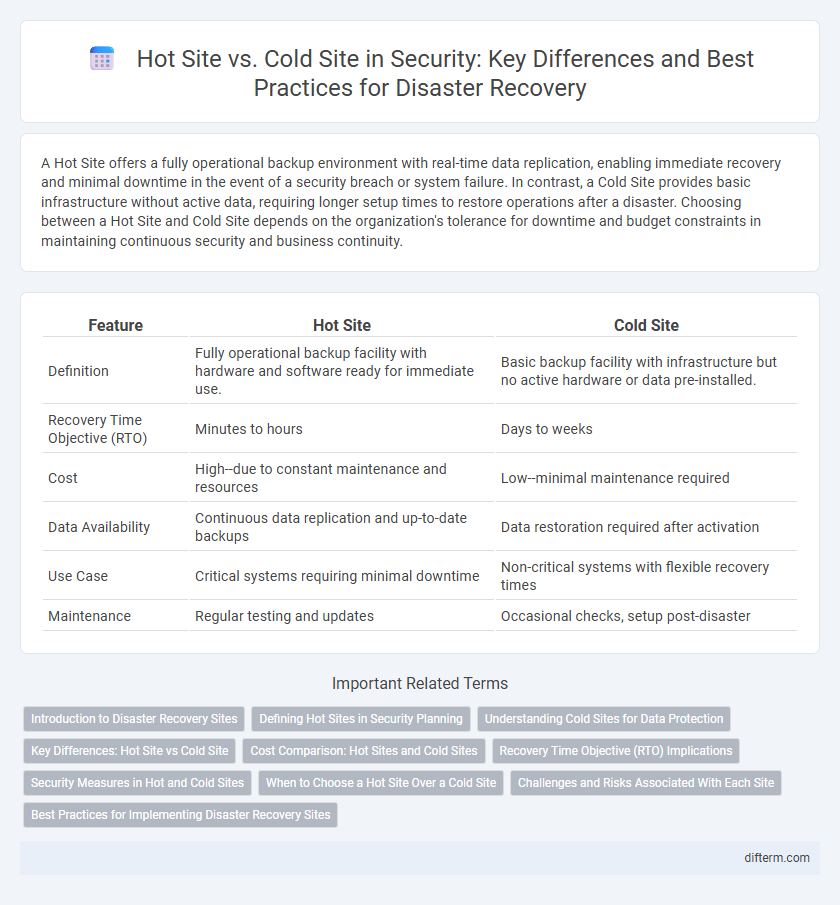A Hot Site offers a fully operational backup environment with real-time data replication, enabling immediate recovery and minimal downtime in the event of a security breach or system failure. In contrast, a Cold Site provides basic infrastructure without active data, requiring longer setup times to restore operations after a disaster. Choosing between a Hot Site and Cold Site depends on the organization's tolerance for downtime and budget constraints in maintaining continuous security and business continuity.
Table of Comparison
| Feature | Hot Site | Cold Site |
|---|---|---|
| Definition | Fully operational backup facility with hardware and software ready for immediate use. | Basic backup facility with infrastructure but no active hardware or data pre-installed. |
| Recovery Time Objective (RTO) | Minutes to hours | Days to weeks |
| Cost | High--due to constant maintenance and resources | Low--minimal maintenance required |
| Data Availability | Continuous data replication and up-to-date backups | Data restoration required after activation |
| Use Case | Critical systems requiring minimal downtime | Non-critical systems with flexible recovery times |
| Maintenance | Regular testing and updates | Occasional checks, setup post-disaster |
Introduction to Disaster Recovery Sites
Disaster recovery sites are critical components for business continuity, with Hot Sites offering fully operational environments equipped with real-time data replication to minimize downtime. Cold Sites provide basic infrastructure without active data or hardware, requiring longer setup times during recovery. Selecting between Hot and Cold Sites depends on an organization's recovery time objectives (RTO) and recovery point objectives (RPO) to balance cost and operational resilience.
Defining Hot Sites in Security Planning
Hot sites in security planning are fully equipped, operational backup facilities designed to ensure immediate business continuity during a disaster. These sites contain real-time data replication, essential hardware, software, and network capabilities, enabling organizations to resume critical operations with minimal downtime. Hot sites are integral to disaster recovery strategies that prioritize rapid response and minimal data loss.
Understanding Cold Sites for Data Protection
Cold sites are backup facilities equipped with power and network connectivity but lack pre-installed hardware or data, requiring organizations to transport and install critical infrastructure during a disaster. These sites offer cost-effective disaster recovery options compared to hot sites but involve longer recovery times, potentially impacting business continuity. Understanding cold sites is crucial for businesses aiming to balance budget constraints with the need for data protection and disaster recovery readiness.
Key Differences: Hot Site vs Cold Site
Hot sites provide fully operational, real-time backup facilities with immediate data replication to ensure minimal downtime during a disaster, whereas cold sites offer empty or basic infrastructure without active data or systems, requiring longer restoration times. Hot sites incur higher costs but support rapid recovery and business continuity, while cold sites are more cost-effective but involve significant delays in system setup and data restoration. The choice between hot and cold sites depends on an organization's recovery time objectives (RTO) and budget constraints.
Cost Comparison: Hot Sites and Cold Sites
Hot sites incur higher costs due to their fully equipped infrastructure, immediate availability, and continuous operation, making them suitable for organizations requiring minimal downtime. Cold sites are significantly less expensive, as they provide only the physical space and basic utilities, requiring additional time and resources to become operational. Cost efficiency favors cold sites for businesses with flexible recovery time objectives, whereas hot sites justify their premium through rapid disaster recovery capabilities.
Recovery Time Objective (RTO) Implications
Hot sites significantly reduce Recovery Time Objective (RTO) by maintaining fully operational systems and up-to-date data, enabling immediate failover during disasters. Cold sites, lacking pre-installed hardware and live data, result in prolonged RTO due to the time needed for setup and data restoration. Organizations prioritizing rapid recovery must invest in hot site solutions to meet stringent RTO requirements effectively.
Security Measures in Hot and Cold Sites
Hot sites implement continuous data replication and real-time system backups, ensuring immediate operational continuity and minimizing data loss during a security breach or disaster. Cold sites lack active data replication and require manual restoration, increasing vulnerability to data breaches and extended downtime risks. Enhanced physical security, controlled access, and network monitoring are critical in hot sites, while cold sites primarily depend on security protocols during setup and reactivation phases.
When to Choose a Hot Site Over a Cold Site
A hot site is ideal for organizations requiring minimal downtime and rapid recovery, especially those with critical systems like financial institutions or healthcare providers. Selecting a hot site ensures immediate access to fully operational infrastructure, including hardware, software, and real-time data replication, which supports business continuity during major disruptions. In contrast, a cold site involves longer setup times, making it less suitable for environments demanding continuous availability and fast restoration.
Challenges and Risks Associated With Each Site
Hot sites face challenges with high operational costs and complex maintenance to ensure immediate data recovery, posing risks of resource allocation inefficiencies. Cold sites carry significant risks due to their lack of real-time data backup and extended downtime during activation, which can lead to prolonged business interruptions. Both site types require careful risk assessment to balance cost, recovery time objectives (RTO), and data integrity in disaster recovery planning.
Best Practices for Implementing Disaster Recovery Sites
Establishing a disaster recovery site involves selecting between a Hot Site, equipped with real-time data replication and immediate failover capabilities, and a Cold Site, which requires manual setup and data restoration, impacting recovery time objectives (RTOs). Best practices include regularly testing failover procedures, ensuring data synchronization between primary and recovery sites, and categorizing applications based on criticality to optimize resource allocation. Implement robust security controls at both sites, such as encryption, access management, and compliance with industry standards like ISO 27001 and NIST to mitigate risks during disaster recovery operations.
Hot Site vs Cold Site Infographic

 difterm.com
difterm.com